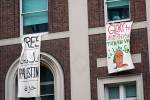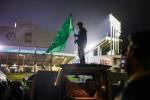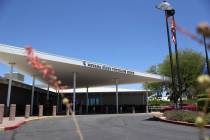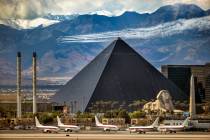Predator strike that killed sailor angers father
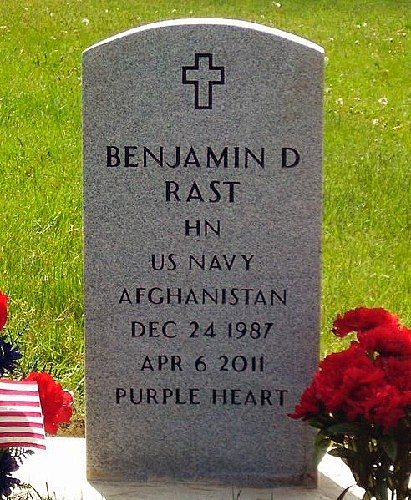
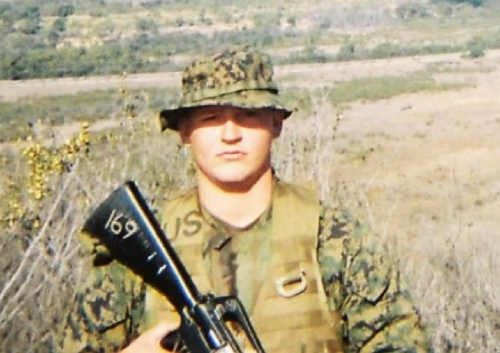

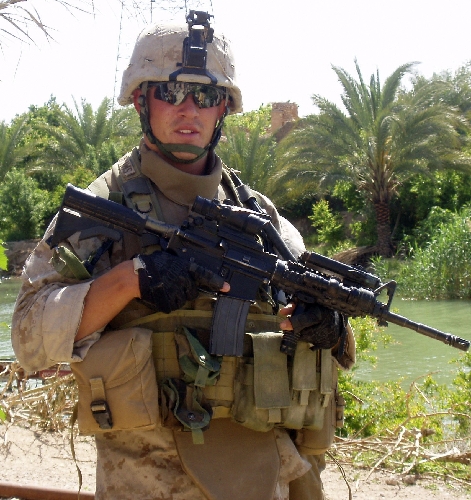

Robert Rast is still searching for answers a year after his son was killed in Afghanistan in the first-ever friendly fire incident involving an Air Force Predator drone missile strike.
He wants Pentagon leaders to hold those who were involved accountable and take bigger steps to prevent accidents like the one that killed Benjamin David Rast, a 23-year-old Navy hospitalman from Niles, Mich., and Jeremy D. Smith, a 26-year-old Marine staff sergeant, from Arlington, Texas.
Benjamin Rast had "a heart of gold with a John Wayne, patriotic fighting spirit," his father said.
"The two-man Predator crew responsible for this particular airstrike not only destroyed a young Navy corpsman’s life but also destroyed the lives of his entire family," Robert Rast wrote in a recent email to the Review-Journal.
In the March 23 email, he criticized the Obama administration and Defense Secretary Leon Panetta for trying "to sweep this serious matter under the Oval Office carpet."
Rast and Smith died a year ago this Friday when a captain at Creech Air Force Base in Indian Springs, 45 miles northwest of Las Vegas, "pushed the red fire button on a joystick," Rast’s father said.
That launched a laser-guided Hellfire missile from a remotely piloted aircraft 7,500 miles away, killing the two men while they fought insurgents in Afghanistan.
Names of those involved and numerous pages of sensitive military and foreign government information were redacted from the report that the U.S. Central Command in Florida provided to the Review-Journal through a Freedom of Information Act request.
Once-secret transcripts and affidavits in the investigation report of the April 6, 2011, incident don’t pin blame squarely on anyone involved: the remorseful Predator crew at Creech, Air National Guard intelligence specialists who monitored the drone’s video feed in Terre Haute, Ind., or Marines on the ground in Afghanistan who called for the missile strike after their platoon was attacked with small arms and machine-gun fire.
The 385-page report concludes that "information was available to the Predator crew that potentially could have increased the commander’s understanding of the situation, but this information was not communicated to Marines on the ground who were directing the attack."
"In the final analysis the chain of events that led to Staff Sgt. Smith and (Hospitalman) Rast being targeted and ultimately killed by friendly fire was initiated by the on-scene ground force commander’s lack of overall situational awareness and the inability to accurately communicate his friendly force disposition with respect to the enemy."
While Rast’s father remains bitter about the military not holding anyone accountable, Smith’s father, Jerry Smith, of Arlington, Texas, was quick to forgive those involved.
"There’s some kid working a joystick that pulled that trigger, and he’s going to have to live with that the rest of his life," Jerry Smith told a Dallas NBC News team days after the incident. "If I had him standing here, I’d hug him. I’d tell him, ‘Man, that stuff happens. … I promise you, he didn’t go over there to kill my son. He went over to save my son. And if he made a mistake, he made a mistake."
REMOTE CONTROL FIGHTING
Within two weeks of the deadly incident, investigating officers interviewed the pilot in command of the armed Predator spy plane and other crew members including a tech sergeant who served as mission intelligence coordinator.
At the time, the pilot had commanded a Predator MQ-1 for almost four years and had racked up more than 2,260 hours in 841 missions flying the remotely piloted aircraft over Iraq and Afghanistan.
In these so-called "remote-split operations," an unmanned Predator is launched from an airstrip in or near the war zone and control of the aircraft is handed off via satellite link to a crew sitting at computer consoles at ground stations such as Creech.
The pilot controls the plane while watching a live video feed with a 2-second delay from the Predator’s high-tech cameras. The view is like looking through a straw at a Google Earth satellite image. Sometimes, intelligence coordinators use Google Earth maps to double-check locations. Predators, as well as the larger, faster, more heavily armed MQ-9 Reapers, also have infrared cameras for night flying and heat detection capabilities.
A sensor operator assists the pilot and can use controls to hold a laser beam steady to guide a Hellfire missile to a target.
The aircraft’s near real-time video feeds can be monitored by commanders on the ground and, in this case, by Air National Guard specialists in Terre Haute, Ind., at a ground station for the Air Force Intelligence, Surveillance and Reconnaissance Agency. The observers can communicate with crews at Creech and other bases by computer, typing "whisper" messages relayed through an Internet chat room system.
THE FOG OF HIGH-TECH WAR
On the day Rast and Smith were killed, the pilot was trying to keep the Predator in position in a 30-knot wind while tracking movements of the Marine reconnaissance platoon as an armored vehicle rolled down a road in the Upper Sangin Valley of Afghanistan’s volatile Helmand province. Marines on foot took cover along a tree line and a canal as they approached a compound of buildings. "Muzzle flashes" from the barrels of rifles or machine guns were detected by the Predator’s camera, but there was confusion among the observers and the pilot as to the direction of the shooting.
"After zooming in and briefly checking day TV, muzzle flashes were observed from the southern most heat (signature)," the pilot told investigators.
"I saw, without a doubt in my mind, muzzle flashes appearing to be in the direction of the convoy," he said. "I did not see the chat in the main mission room after seeing muzzle flashes."
The "chat" that "personnel were shooting west" was relayed to the mission intelligence coordinator, a tech sergeant trainee working in a closed room at Creech who posted a "possible muzzle flashes" message.
About that time, Rast, Smith and a third Marine had taken cover near the compound and were shooting at enemy combatants holed up in some buildings.
According to the investigation report, in local time in Afghanistan, here’s what happened:
■ 8:42 a.m.: The tech sergeant trainee at Creech asks his trainer/supervisor for assistance "due to the escalation of events."
■ 8:43 a.m.: A verbal warning is radioed to ground forces from an unidentified source that "enemy has been located southwest of Building 58. … Get your guys down. Danger close."
The Marine second lieutenant then tells his platoon about the impending missile strike, saying, "Get behind cover and report back."
At this point, monitors at the Indiana ground station know they can’t intervene in the operation unless they see an imminent violation of the Law of Armed Conflict, such as women or children in the field of view.
■ 8:45 a.m.: The supervisor in Indiana opens a computer chat with the mission intelligence coordinator at Creech, because a review of the video feed showed that the targeted personnel are shooting to the west and the friendly convoy is positioned to the east.
"The information from the private chat regarding the direction of fire of personnel in the field of view was never passed to the pilot or sensor operator by the (mission intelligence coordinator) trainee or trainer," investigators reported.
■ 8:47 a.m.: The Creech coordinator sends a message back to the observers in Indiana to "double-check coordinates."
■ 8:49 a.m.: The reply comes, confirming that the coordinates posted are the same for the individuals in the Predator’s view.
■ 8:50 a.m.: The Creech intelligence coordinator trainee is told by his supervisor to type "distance is off," when he meant instead to say "direction is off."
It is too late.
The Predator crew already is "cleared hot" to launch a Hellfire missile, even though at the moment a Marine corporal checks grid coordinates for the target and tells his sergeant that "Building 58 is the wrong building."
While most of the platoon takes cover in a nearby canal, Rast and Smith fall to a prone position with the Hellfire missile in flight and only 17 seconds away from striking their location.
■ 8:51 a.m. — The pilot radios "splash," indicating that the missile has hit its target. That is followed by a call from a sergeant on the ground to "cease fire" because a "friendly" — Smith — has been killed in action, and Rast, too, has suffered mortal wounds.
REALIZING THE MOMENT
The pilot told investigators there "was never a time when I felt the strike should have been aborted in order to verify friendly position."
"Experience with finding and neutralizing the enemy is that targets can be fleeting and the window to strike can be very small."
He sensed a problem when U.S. friendlies entered the target area without being fired upon.
"I realized with certainty something was wrong. Even then, my thoughts were, ‘Were these ANA (Afghan National Army soldiers) gone rogue and firing on friendlies?’ "
After the strike, the pilot held the Predator in viewing position until helicopters arrived.
"It was then that the gravity of the matter overcame my ability to continue focusing on the task at hand and I decided to have the mid shift pilot relieve me," he wrote to investigators.
The crew and the squadron commander then went to a briefing room at Creech.
"It was while watching the video for the first time in the briefing room that I saw the direction of fire was actually to the west," the pilot recalled.
"Realizing this fact and being completely confused at how I saw exactly the opposite sitting in the seat, I could not maintain bearing and stopped the video and left … the building. At this point, the chaplain met me outside."
The mission intelligence tech sergeant told investigators, "I feel terrible for everyone.
"We replayed this 100 times in our head trying to figure out what quite went wrong and I guess that’s really the struggle. If we can’t pull lessons learned out of this … which we all hope to do in clear, concise thought, I think that would be the only good that came out of this."
LESSONS LEARNED
On May 28, Army Gen. David H. Petraeus sent the findings of the investigation to commanders in Afghanistan "for whatever disciplinary or administrative actions, if any."
On Tuesday, an Air Force spokeswoman at the Pentagon responded to a Review-Journal query about lessons learned and actions taken.
"The investigation found no culpable negligence or dereliction of duty by anyone involved in the incident," Air Force Maj. Tracy Bunko wrote.
"It also concluded that there was a lack of full situational awareness about friendly positions among portions of the full complement of war fighters. … The report suggested improving communications equipment and techniques as well as refining fire support procedures and incorporating those recommendations into future training."
She said efforts were ongoing late last year to establish two-way voice communication between common ground stations, like the one in Indiana, and crews of remotely piloted aircraft.
Robert Rast said he has read the investigation report and watched the Predator video and is convinced that "incompetence and negligence on the part of the U.S military" is what caused his son’s death. That is why his family has asked that the Pentagon and Obama administration officials take a much closer look at this incident.
"From the officers of the 2nd Recon Marine Battalion located at Camp Alcatraz that ordered the Predator strike to the Air Force analysts in Terre Haute viewing the incident as it was happening to the two-man Predator crew that fired on indiscernible thermal images, this was clearly an accident that should not have happened," Rast said Wednesday.
APOLOGETIC LEADERS
The April 6, 2011, incident was the first report of a remotely piloted aircraft firing a laser-guided missile and killing U.S. troops. It’s the exception rather than the rule considering there have been hundreds of thousands of hours of successful Predator and Reaper operations, which have saved countless lives of U.S. and coalition forces.
Yet, dozens of Afghan civilians have been killed during drone operations in the U.S.-led war against the Taliban and insurgents that followed the Sept. 11, 2001, terrorist attacks.
U.S. military investigators found that "inaccurate and unprofessional" reporting by a Creech Air Force Base Predator crew was responsible for a helicopter missile strike that killed 23 Afghan civilians in Uruzgan province on Feb. 21, 2010.
Gen. Stanley McChrystal, the U.S. and NATO commander, called on the Air Force to investigate the Predator crew’s actions during the deadly attack on a civilian convoy. Investigators then found discrepancies in communication, information exchange, experience levels and decision-making by ground and air assets.
The Predator’s cameras had tracked the convoy for more than three hours; but the crew at Creech didn’t realize that women and children were in the trucks even though, as in the friendly fire incident, intelligence specialists monitoring the video feed had sent computer messages to the crew and ground commanders warning that children were visible.
McChrystal apologized to Afghanistan President Hamid Karzai, saying the inadvertent killing of civilians "is heartbreaking and undermines their trust and confidence in our mission."
Similarly, Petraeus, then-commander of the International Security Assistance Force in Afghanistan, expressed his "deepest sorrow over the deaths" of Smith and Rast in the 2011 friendly fire incident.
"The loss of Jeremy and Benjamin leaves an absence in our ranks that cannot be filled. That absence rests in the hearts and minds of the men and women who served with them," Petraeus wrote. "Though no words I can offer will assuage the grief that accompanies such an unfortunate tragedy, I hope that Jeremy’s and Benjamin’s family and friends find some measure of comfort in knowing they served with honor and were well respected by their unit and the chain-of-command."
Contact reporter Keith Rogers at krogers@reviewjournal.com or 702-383-0308.






